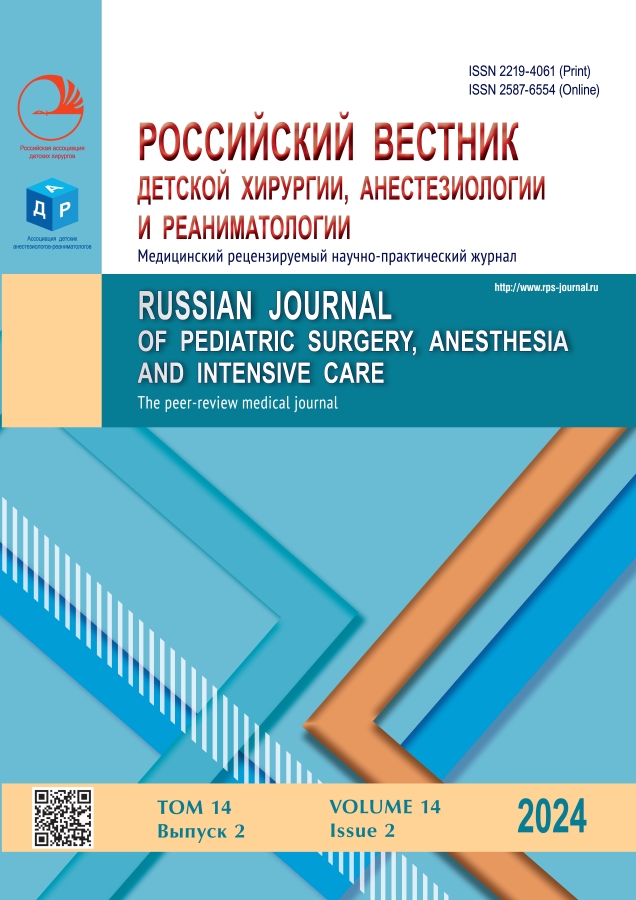含红细胞血液成分在出生后最初几个月的儿童围手术期的应用
- 作者: Mezhevikina V.M.1,2, Zhirkova Y.V.1,2, Lazarev V.V.1
-
隶属关系:
- Pirogov Russian National Research Medical University
- Speransky Children’s Hospital No. 9
- 期: 卷 14, 编号 2 (2024)
- 页面: 195-205
- 栏目: Original Study Articles
- URL: https://journals.rcsi.science/2219-4061/article/view/263100
- DOI: https://doi.org/10.17816/psaic1529
- ID: 263100
如何引用文章
全文:
详细
现实意义。对于患有外科疾病的儿童,贫血可以在术前被诊断出来,也可能在手术治疗过程中发生,还可能在术后发展和恶化。贫血与手术治疗后发病率增加、严重并发症甚至死亡有关。 目的旨在确定出生后最初几个月的儿童在围手术期输注含红细胞成分的频率和适应症。
材料与方法。一项基于Speransky Children’s City Clinical Hospital No. 9的队列研究,包括187名儿童。研究了血红蛋白、血细胞比容和红细胞水平,评估了术中失血量,记录了血液动力学指标、出血性综合征以及围手术期使用肾上腺激素的情况。我们记录了在围手术期的哪个阶段(术前、术中或术后)进行了含红细胞成分的输血。我们使用R 4.3.0统计计算环境对数据进行了统计分析。
结果。手术时患儿的年龄为41(16.5-63)天[5.9(2.4-9)周]。其中,64名儿童(34.2%)出生一个月, 72名儿童(38.5%)出生两个月,51名儿童(27.3%)出生三个月。早产儿有76人(40.6%)。102名儿童(54.5%)接受了紧急手术,85名儿童(45.5%)接受了计划手术。输注含红细胞成分的血红蛋白、血细胞比容和红细胞水平分别为82(77-90)克/升、25(22-28)%和2.8(2.3-3.0) × 1012/升。含红细胞成分的体积为54.0(32.9-74.4)毫升(每公斤体重10-30毫升)。术后需要人工通气的病例为31例(72.1%), 人工通气时间为48.5小时(22.5-190),而没有输注含红细胞成分的病例为57例(39.6%),人工通气时间为40小时(22-96)。输血指征为不同程度的贫血。然而,值得注意的是,74.4%的患儿在输血的同时接受了拟肾上腺素治疗,以稳定血流动力学:23名(74.2%)患儿接受了多巴胺单药治疗, 8名(25.8%)患儿接受了多巴胺和去甲肾上腺素联合治疗。药物剂量分别为10(8-12)毫克/千克 × 分钟和0.2(0.15-0.4)毫克/(千克 × 分钟)。
结论。使用含红细胞成分的频率为23%。输注含红细胞成分的阈值:血红蛋白82(77-90)克/升,血细胞比容 25 (22-28)%,红细胞 2.8 (2.3-3.0)×1012/升。
作者简介
Valentina M. Mezhevikina
Pirogov Russian National Research Medical University; Speransky Children’s Hospital No. 9
编辑信件的主要联系方式.
Email: mezhevikina.valentina@gmail.com
ORCID iD: 0000-0001-5217-4641
SPIN 代码: 4965-6597
俄罗斯联邦, Moscow; Moscow
Yulia V. Zhirkova
Pirogov Russian National Research Medical University; Speransky Children’s Hospital No. 9
Email: zhirkova@mail.ru
ORCID iD: 0000-0001-7861-6778
SPIN 代码: 5560-6679
MD, Dr. Sci. (Medicine), Professor
俄罗斯联邦, Moscow; MoscowVladimir V. Lazarev
Pirogov Russian National Research Medical University
Email: examlpe@address.ru
ORCID iD: 0000-0001-8417-3555
SPIN 代码: 4414-0677
MD, Dr. Sci. (Medicine), Professor
俄罗斯联邦, Moscow参考
- Shander A, Lobel GP, Javidroozi M. Anesthesia for patients with anemia. Anesthesiol Clin. 2016;34(4):711–730. doi: 10.1016/j.anclin.2016.06.007
- Colombatti R, Sainati L, Trevisanuto D. Anemia and transfusion in the neonate. Semin Fetal Neonatal Med. 2016;21(1):2–9. doi: 10.1016/j.siny.2015.12.001
- Goobie SM, Faraoni D, Zurakowski D, DiNardo JA. Association of preoperative anemia with postoperative mortality in neonates. JAMA Pediatr. 2016;170(9):855–862. doi: 10.1001/jamapediatrics.2016.1032
- Khovasova NO, Naumov AV, Tkacheva ON. Perioperative anemia. Medical Council. 2021;(12):398–404. EDN: EFBXRD doi: 10.21518/2079-701X-2021-12-398-404
- Ree IMC, Lopriore E. Updates in neonatal hematology: causes, risk factors, and management of anemia and thrombocytopenia. Hematol Oncol Clin North Am. 2019;33(3):521–532. doi: 10.1016/j.hoc.2019.01.013
- Cunningham KE, Okolo FC, Baker R, et al. Red blood cell transfusion in premature infants leads to worse necrotizing enterocolitis outcomes. J Surg Res. 2017;213:158–165. doi: 10.1016/j.jss.2017.02.029
- Fuchs A, Disma N, Virág K, et al. Peri-operative red blood cell transfusion in neonates and infants: Neonate and children audit of anaesthesia practice in Europe a prospective European multicentre observational study. Eur J Anaesthesiol. 2022;39(3):252–260. doi: 10.1097/EJA.0000000000001646
- Dukleska K, Vinocur CD, Brenn BR, et al. Preoperative blood transfusions and morbidity in neonates undergoing surgery. Pediatrics. 2020;146(5):e20193718. doi: 10.1542/peds.2019-3718
- Antonov AG, Degtyarev DN, Narogan MV, et al. Hemolytic disease of the fetus and newborn. Clinical practice guideline. Neonatology: news, views, education. 2018;6(2):131–142. EDN: URMNTI
- Sheibak LN. Modern concept of hemolytic disease features of the fetus and newborn. Journal of the Grodno State Medical University. 2015;(1):134–138. EDN: TNBTLV
- Pshenisnov KV, Aleksandrovich YuS. Massive blood loss in pediatric practice. Russian journal of hematology and transfusiology. 2020;65(1):70–86. EDN: CFAJVB doi: 10.35754/0234-5730-2020-65-1-70-86
- Geraskin IV, Geraskin VA, Geraskina NV. Effect of hemotransfusions in newborns and infants on the composition and oxygen affinity of physiological hemoglobin. Pathological physiology and experimental therapy. 2023;67(1):71–78. EDN: RQUOQG doi: 10.25557/0031-2991.2023.01.71-78
- Akselrod BA, Balashova EN, Bautin AE, et al. Clinical guidelines for red blood cell transfusion. Russian journal of hematology and transfusiology. 2018;63(4):372–435. EDN: ZYOPRB doi: 10.25837/HAT.2019.62.39.006
- Grigor'ev EV, Lebedinskii KM, Schegolev AV, et al. Resuscitation and intensive care in acute massive blood loss in adults (clinical guidelines). Russian Journal of Anesthesiology and Reanimatology. 2020;(1):5–24. EDN: PVTIQM doi: 10.17116/anaesthesiology20200115
- Habre W, Disma N, Virag K, et al. Incidence of severe critical events in paediatric anaesthesia (APRICOT): a prospective multicentre observational study in 261 hospitals in Europe. Lancet Respir Med. 2017;5(5):412–425. doi: 10.1016/S2213-2600(17)30116-9
- New HV, Berryman J, Bolton-Maggs PH, et al. Guidelines on transfusion for fetuses, neonates and older children. Br J Haematol. 2016;175(5):784–828. doi: 10.1111/bjh.14233
- Wittenmeier E, Troeber C, Zier U, et al. Red blood cell transfusion in perioperative pediatric anesthesia: a survey of current practice in Germany. Transfusion. 2018;58(7):1597–1605. doi: 10.1111/trf.14581
- Doctor A, Cholette J, Remy KE, et al. Recommendations on RBC transfusion in general critically ill children based on hemoglobin and/or physiologic thresholds from the pediatric critical care transfusion and anemia expertise initiative. Pediatr Crit Care Med. 2018;19(9S):98–113. doi: 10.1097/PCC.0000000000001590
- Howarth C, Banerjee J, Aladangady N. Red blood cell transfusion in preterm infants: current evidence and controversies. Neonatology. 2018;114(1):7–16. doi: 10.1159/000486584
补充文件







